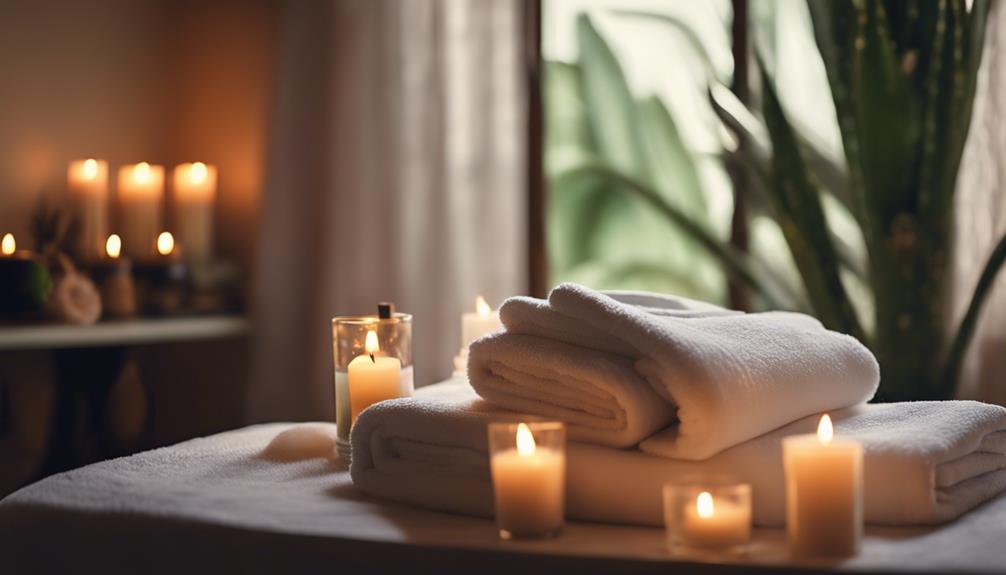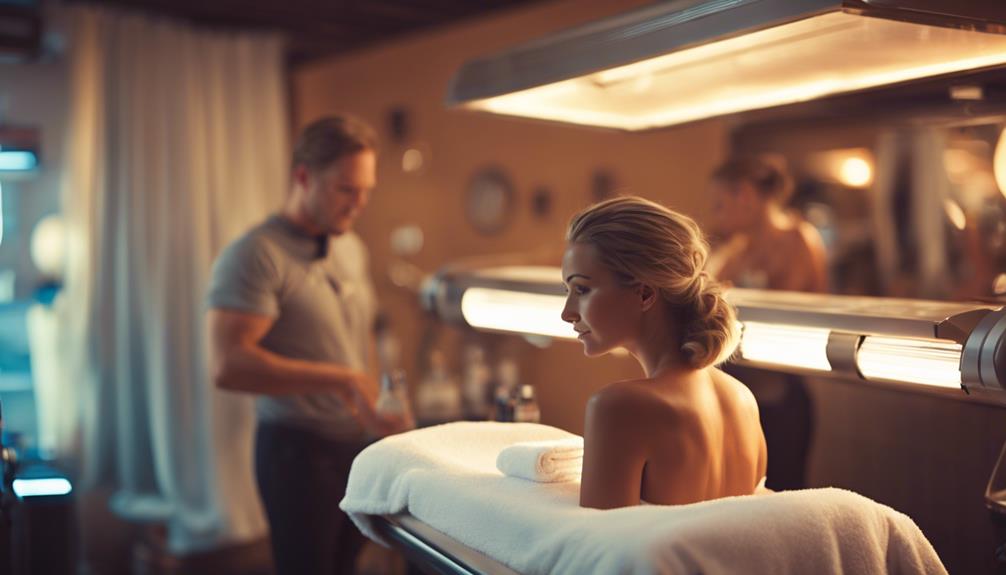Perfecting your tanning bed routine is easier than you think! Start by figuring out your skin type; some folks burn faster than others. Begin with short sessions, maybe two to three a week, and always let your skin chill out for at least 48 hours in between. Don't forget to exfoliate beforehand and slather on moisturizer afterward to keep that glow! Protect those peepers with goggles, and make sure to clean the bed before you hop in. It's all about finding that sweet spot—too much can lead to regrets! Stick around, and you'll discover even more tips to shine bright!
Key Takeaways
- Assess your skin type to determine safe UV exposure and tailor your tanning sessions accordingly.
- Start with shorter tanning sessions, gradually increasing duration while allowing a minimum of 48 hours between sessions.
- Exfoliate 24 hours before tanning and keep your skin moisturized to enhance tanning effectiveness and appearance.
- Use eye protection during sessions and regularly clean the tanning bed to prevent irritation and ensure safety.
Skin Type Assessment
To get the best tanning results, it's crucial to assess your skin type, as this determines how much UV exposure your skin can safely handle.
Are you the pale type that burns like a lobster, or do you have that nice golden tan? Knowing your skin type helps you avoid painful sunburns and get the perfect glow. If you're unsure, don't hesitate to consult a tanning pro; they can help you figure it out.
Also, remember to exfoliate your skin 24 hours before tanning—trust me, your skin will thank you!
And don't forget to moisturize! Hydrated skin not only looks better but also tans better.
Tanning Session Scheduling

Scheduling your tanning sessions wisely is essential for achieving a beautiful, lasting tan while keeping your skin healthy.
Start with shorter sessions and gradually increase the time as your skin gets used to it. Trust me, you don't want to end up looking like a lobster!
Aim for 2-4 sessions a week, but if you're a newbie, stick to 2-3. Oh, and don't forget to take a break!
Give your skin at least 48 hours to chill before your next visit. This way, you'll avoid overexposure and keep your glow looking fresh.
Remember, it's all about balance—too much tanning can lead to skin troubles, and we definitely don't want that!
Skin Recovery Strategies

After your tanning sessions, it's important to focus on skin recovery to maintain that radiant glow and keep your skin healthy.
First up, give your skin at least 48 hours to chill out before diving into another session. It's like giving your skin a mini-vacation!
Slather on some post-tan moisturizer to keep it hydrated and happy—nobody likes dry skin, right? You can even try tan extenders to help your color last longer.
And don't forget to drink plenty of water; your skin will thank you!
Safety Measures

Maintaining safety during tanning sessions is essential for protecting your skin and ensuring a positive experience. You want that glow, but not at the cost of your health, right?
So, here are a few key safety measures to keep in mind:
- Wear Eye Protection: Always use tanning bed goggles to shield your eyes from harmful UV rays. Regular sunglasses just won't cut it!
- Clean the Bed: Wipe down the tanning bed before you hop in. A little disinfectant goes a long way in preventing skin irritation.
- Check Equipment: Make sure the bulbs are in good shape. Old bulbs can lead to uneven tanning and even skin damage.
Stay safe and enjoy your tanning sessions! You've got this!
Equipment Maintenance

Regularly inspecting and cleaning your tanning bed is essential for ensuring a safe and effective tanning experience. Think of it as giving your bed a spa day! You wouldn't want to lie down on a dirty surface, right?
Wipe down the surface with disinfectant designed for tanning beds to keep pesky germs away. Don't forget to check the bulbs every 500-1000 hours; dim lights mean less tan!
Also, peek at the ventilation to avoid turning your tanning session into a sauna. Finally, give your bed a quick look for any wear and tear.
A little maintenance goes a long way, making your tanning experience not just fun but safe, too! So, roll up those sleeves and show your bed some love!
Frequently Asked Questions
Can I Tan if I Have a Sunburn?
You shouldn't tan with a sunburn. Your skin needs time to heal, and tanning could worsen irritation or damage. Wait until your sunburn fully recovers before considering any tanning sessions for ideal skin health.
What Should I Wear During a Tanning Session?
During a tanning session, wear minimal clothing to maximize exposure, like a bikini or swimwear. Avoid tight fabrics that can leave marks, and consider using a protective tanning lotion for ideal results and skin health.
How Can I Prevent Streaks While Tanning?
Did you know that nearly 30% of indoor tanners experience streaks? To prevent streaks, exfoliate beforehand, apply a quality tanning lotion evenly, and guarantee you're well-hydrated. Regular moisturizing helps maintain an even, radiant tan.
Is It Safe to Tan During Pregnancy?
It's generally advised to avoid tanning during pregnancy. Your skin's sensitivity increases, and UV exposure could harm you and your baby. Consult your doctor for personalized recommendations on safe alternatives for maintaining a healthy glow.
Can I Use Tanning Beds if I Have Acne?
If acne's your unwelcome guest, using tanning beds can be tricky. They might aggravate your skin, so consult a dermatologist first. Your skin deserves care, not a sun-soaked gamble that could worsen the situation.
Conclusion
So, there you have it! Tanning beds can give you that golden glow, but remember: 'Rome wasn't built in a day.'
Take your time, know your skin, and don't rush the process. With the right prep, scheduling, and care, you'll rock that sun-kissed look in no time!
Just keep your safety gear handy, and don't forget to hydrate.
Trust me, your skin will thank you for it later!
Happy tanning, friends!










